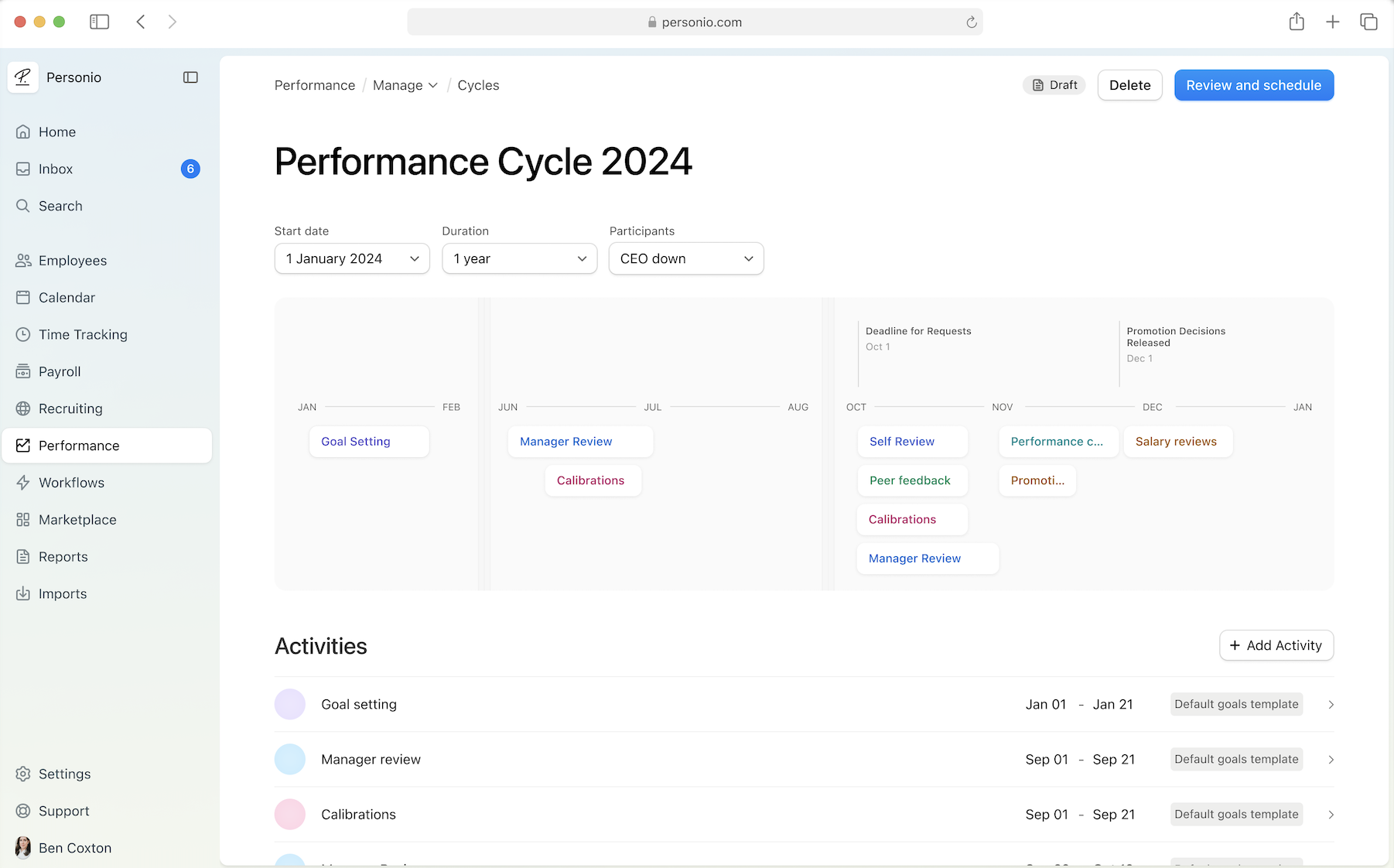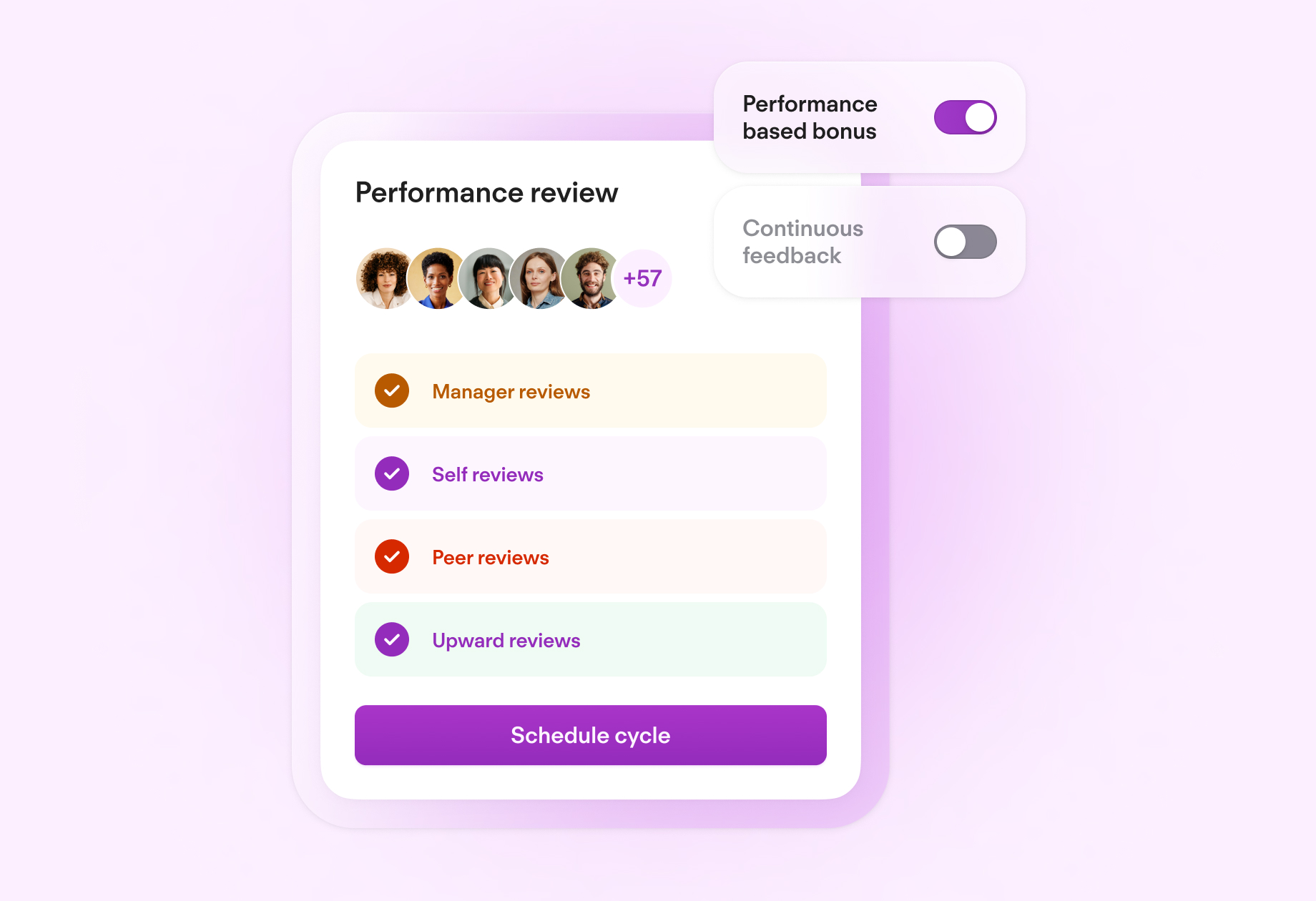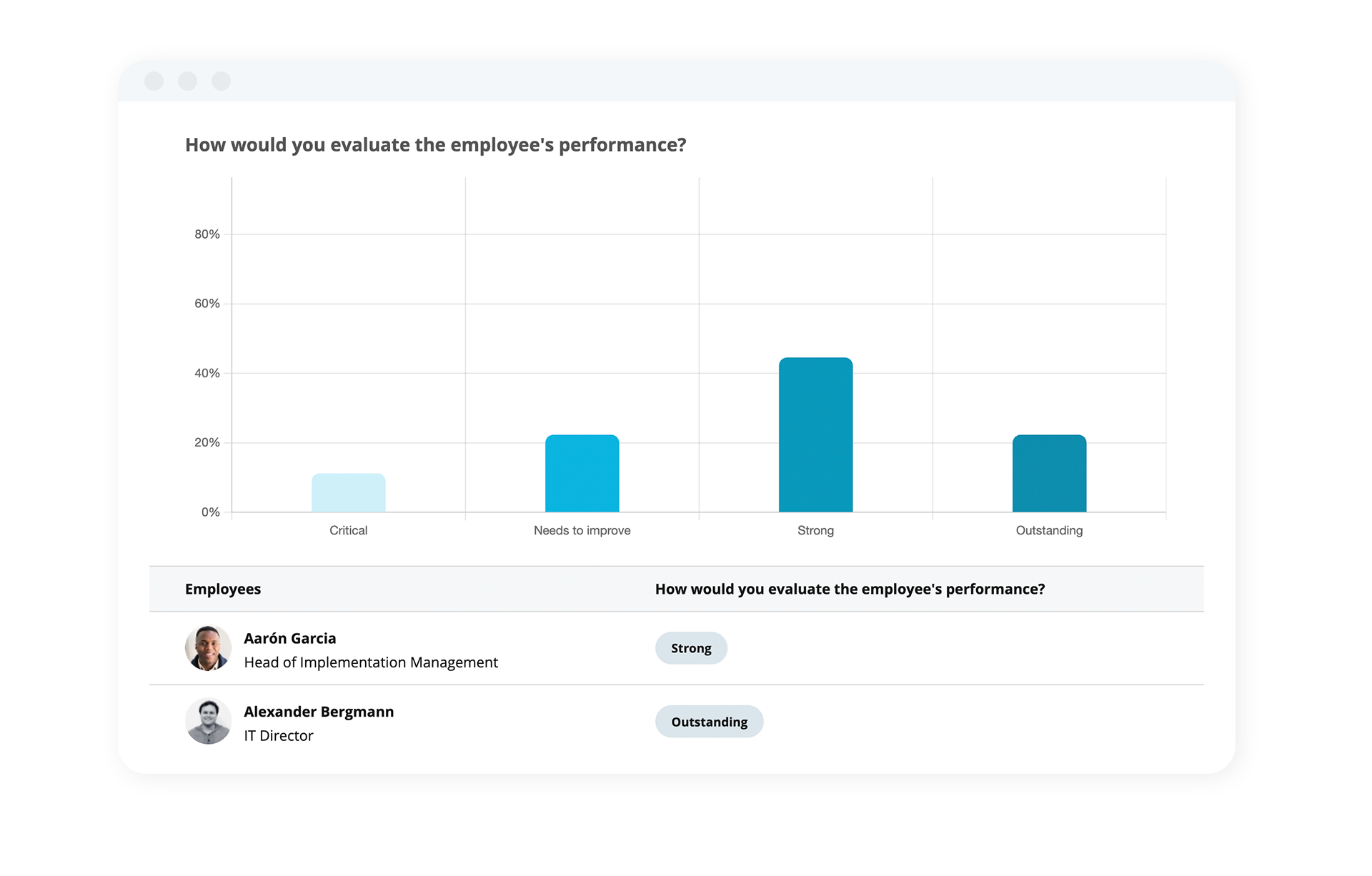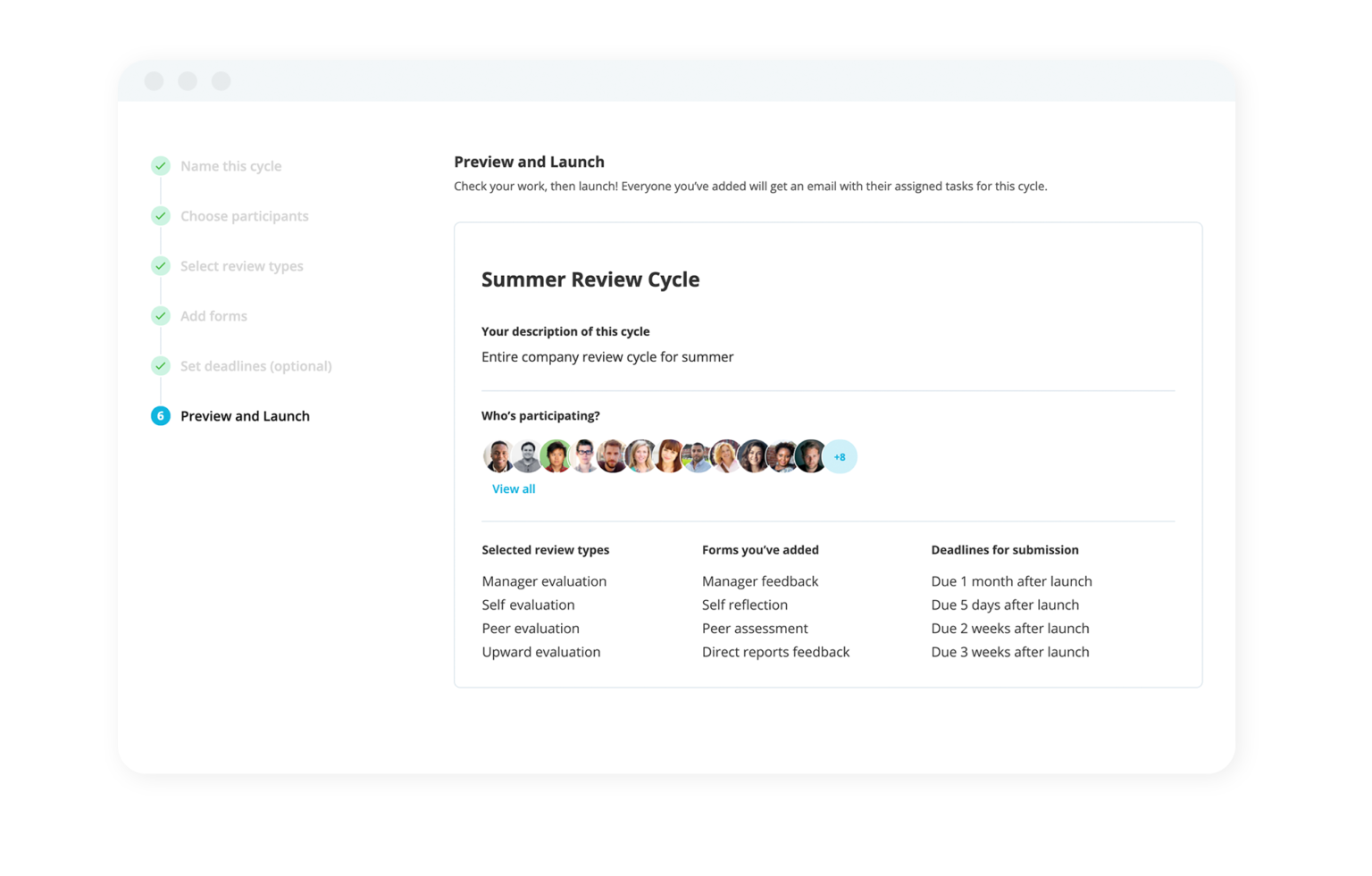
Centralise HR processes in a single platform
Create HR workflows and build better review cycles with Personio's intuitive performance management software
Find out morePerformance Review 101: Process, Tips & Template

How do you host a performance review? Or, how do you design and manage a next-level performance review process? In this article, we introduce the facts and break down the best practices to amazing performance reviews.
Key facts
Performance reviews help leaders and line managers identify areas where employees are succeeding and where they can improve.
The most successful performance reviews include the employee’s active participation in their development.
Employees should be involved early in the review process to help them prepare and take steps following their review.
Contents
- 1What is an employee performance review?
- 2Performance review goals
- 3What does a great performance review process look like?
- 4Traditional vs modern performance reviews
- 5What skills are assessed in performance reviews?
- 6How to prepare for a performance review
- 7Best practices for a great performance review
- 8Mistakes to avoid during performance reviews
- 9Performance reviews run better with Personio
What is an employee performance review?
An employee performance review, often referred to as a performance appraisal or evaluation, is a formalised process used to assess and evaluate an employee's contributions, performance and overall effectiveness.
The purpose of an employee performance review is to provide:
A general assessment of skills and abilities
An evaluation of past performance and achievements
A look ahead to future performance and development
A platform for sharing and communicating feedback
Any improvement or disciplinary measures required
An opportunity for any decisions to be made (promotion, etc.)
Performance reviews help employees understand their strengths and weaknesses, set goals for improvement and align their work with the company's goals.
It is most typically grounded by a meeting between an employee and their manager where they discuss all of the above.
Why do performance reviews matter?
Performance reviews matter for both professional development and business performance purposes. They exist as a way to identify high performers, address underperforming employees, set expectations for performance and behaviour in the workplace and resolve issues before they escalate.
This dual relationship is really important to highlight. Many employees and employers may view performance reviews as a tick-box exercise. Running them only because they know they need to happen, and not because they can drive results.
In fact, the occurrence of structure performance reviews come with a host of benefits:
More motivated employees (higher satisfaction)
Increased business performance and productivity
Higher rates of retention and lower rates of regretted attrition
Improved employer branding and employee referral rates
And more...
Performance review goals

What about goals? For an employee performance review to be a success, it should hit on one (or multiple) of the following goals:
Assessing employee performance: Evaluating an employee's job-related skills, competencies and accomplishments.
Providing feedback: Offering constructive feedback on past performance and areas where an employee could improve.
Setting expectations: Getting clear on what an employee is expected to accomplish (to inform future performance criteria).
Identifying development areas: Finding areas where an employee could improve to help them and the business grow and succeed.
Supporting career growth: Discussing aspirations and pathways for advancement within an organisation.
Documenting performance: Maintaining a clear record of past, present and future employee performance.
What does a great performance review process look like?
A successful performance review fosters employee engagement and energises your entire workforce. On the other hand, reviews that unfairly judge can be an unnecessary source of friction. Equitable reviews are vital to the growth of your business.
When thinking about how to conduct a performance review, there are several elements necessary to conduct the most effective performance review possible. They include:
Best practice | Explained |
|---|---|
Frequency | Branch beyond the traditional annual review to implement quarterly or monthly performance reviews. This way you can keep on top of your employee’s progress, ensuring the employee’s goals and your expectations remain aligned in the long term. |
Dialogue | In a successful performance review, the employee’s input is considered equal to that of the managers. The meeting is about their development, so a two-way conversation is vital for best results. |
Focus | While looking at past performance is important, it shouldn’t be the meat of the conversation. Instead, managers should look ahead and offer opportunities that help workers close skill gaps or poor performance areas. |
Transparency | Workers should be brought into the performance review process early, involving them in the planning and execution to help mitigate anxiety. Both managers and employees should enter a meeting calm and collected because they know exactly what to expect. |
Objectivity | Performance reviews based on personal opinion are subject to bias and could potentially produce poorer outcomes. Businesses typically have a lot of employee data, so every statement a manager makes within the meeting should be backed by observations. |
Traditional vs modern performance reviews
What is the difference between a more traditional versus a modern approach to performance reviews? Let’s review the basics against one another…
Traditional reviews | Modern reviews |
|---|---|
Usually annual | Monthly or quarterly |
Mostly used to determine pay | Mainly used to encourage professional development |
Feedback comes from one supervisor | Feedback comes from several colleagues |
Often used to rank employees by their performance | Often used to motivate employees to improve their performance |
Usually subjective | Usually objective |
The manager primarily leads the meeting | The employee’s input is encouraged |
Focus is on reflecting on the past and examining what went well for the employee and what didn’t | Focus is on using the past to inform the employee’s future development |
A survey by Accenture from 2016 found that, among 2,100 managers and employees, 94 per cent of the surveyed executives agreed with the statement that "performance reviews help to improve business results." But only 40 per cent believed that the current appraisal methods and processes are fit for purpose.
Similar results echo among employees: Two thirds don't believe that their performance is evaluated objectively, and for almost 60 per cent, their performance review is a net negative experience. Nine out of ten firmly believe that a different form of performance review would make them work better.
What does this tell us? Essentially, that performance processes are a little bit broken and are in need of some love. There needs to be more focus on a consistent, equitable and positive performance review experience.
Build a consistent performance review process at scale

Personio's all-in-one HR software allows busy HR teams to design, build and implement performance management cycles in a holistic and automated way. No more worrying about whether reviews happen. Instead, your team can focus on ensuring they're fair.
Learn about Performance with PersonioWhat skills are assessed in performance reviews?

What’s covered during a performance review tends to vary between employees to provide more focused feedback.
However, specific skills are evaluated in nearly every performance review.
Collaboration. This measures how well the employee works with colleagues. Teamwork helps your workforce accomplish more significant projects and a challenging team member can slow down the workflow.
Problem-solving. This assesses how creatively and effectively an employee overcomes obstacles without input from a supervisor. Poor problem-solving skills can lead to operational inefficiencies that reduce company productivity.
Punctuality. This reviews an employee’s timeliness to work. Not every absence is for trivial reasons, but a history of unexcused absences puts more pressure on that worker’s colleagues.
Communication. This measures how clearly an employee can convey their ideas. Well-developed lines of communication are essential to keeping your business running smoothly. Frequent miscommunications can cost the company time and resources to fix a mistake.
Work quality. This assesses how well an employee completes their work on average. The tasks assigned to your workforce are meant to further larger company objectives. An employee who turns in low-quality work often hinders the pursuit of your company’s overall goals.
Ability to accomplish goals. This reviews how the employee meets deadlines. This skill is vital for everyday tasks but also informs how well the worker will be able to meet performance milestones after a review.
How to prepare for a performance review
Both parties need to come prepared to the performance review for the most positive impact. Laying the groundwork before stepping into the room ensures that the meeting maintains a positive and constructive tone.
Preparing as a manager | Preparing as an employee |
|---|---|
Set expectations. A performance review shouldn’t catch your employees off guard. Make sure your team knows what to expect walking in. Collaborate to create an agenda with them so they know which topics are up for discussion. | Review the job description. Employees should review the requirements of their role and self-assess to determine where they excel and need improvement. |
Pick a location. The location of the meeting speaks volumes about the desired tone. For instance, holding the meeting in your office establishes a more formal atmosphere. A conference room or lounge (with privacy, of course) can encourage better conversation. | Highlight accomplishments. Employees should put together information about their achievements since their last performance review. Positive feedback from colleagues and direct management reports, for example, can help demonstrate their value to the company. |
Clear your schedule. Conducting performance reviews is time-consuming but worth it. Set aside time to truly focus on the task at hand. | Expect criticism. Expect to receive constructive criticism. Accepting that feedback and asking for more detail can help make the necessary changes to how you work. |
Enable your line managers to host great performance conversations

Download our performance review template to help your teams design, structure and run performance reviews that truly make the grade. Grab your copy for free right now.
Find your copy hereBest practices for a great performance review
While setting up the overall performance review process is important, there are many things managers can do to help it run smoothly.
Be honest. It’s constructive criticism that helps your employees grow, and while some behaviours or situations might be uncomfortable to address, avoiding them allows a potential problem to fester.
Make it face-to-face. Video conferencing risks one or both parties getting distracted, and active listening is key to the performance review to ensure the information shared is understood.
Be objective. Back up all your feedback with observations of the employee’s work habits, so they have context for the issues you bring up. Otherwise, it could raise the risk of miscommunication.
End on a high. Your feedback should be as tactful as possible, but it’s a good habit to avoid ending on critique. Finishing with a positive comment on their performance helps motivate employees to act.
Use tact. Employee stress often runs high during a performance review, so the manager must be mindful of how they deliver feedback. If the review sounds too much like a reprimand, it can damage performance rather than elevate it.
Make it a conversation. Encourage your employees to offer their input. If they’re actively participating in their professional development, they’re often more engaged in trying to improve.
Pick the proper setting. Discuss where the review should happen with your employee or let the employee choose the location. Meeting in a familiar, neutral place helps employees feel more comfortable.
Mistakes to avoid during performance reviews

Here are some of the biggest mistakes that organisations should look to avoid when they are running the performance review or performance management process.
Infrequent reviews | Reviews need to be done consistently, but also frequently. Consider having your "big performance review" once a year, but bake in some "light touches" between line managers and employees throughout the year (perhaps quarterly or bi-annually). |
Unclear reviews | The result of a review should never be a surprise for an employee. Be sure to signal to employees when their performance is good, and when it's less than good, prior to their review. And, be clear with managers during reviews to be clear in their evaluation of employees. |
Generic reviews | A performance review template can go a long way, but it still needs a bit of unique flavour befitting your company. Think about your culture and values and how you can create a performance review in line with your company values. |
Poorly-prepared reviews | Managers should be expected and enabled to have the time to prepare performance reviews. This typically relies on an HR software to help manage and automate the processes around reviews (so managers and HR can focus on the quality of reviews and not simply ensuring they happen at all). |
Enable your line managers to host great performance conversations

Download our performance review template to help your teams design, structure and run performance reviews that truly make the grade. Grab your copy for free right now.
Find your copy herePerformance reviews run better with Personio
As part of our all-in-one HR software solution, Personio helps busy HR teams design and run performance cycles at scale. That means a more consistent, compelling performance review for your entire organisation.
All you have to do is put together your cycle, built to your team's liking, assign it to the people already in your system, and then click "run" to ensure that performance reviews happen when they should happen (without leaving anything to luck).
See how to build your very own cycle by clicking here.
Tired of running cumbersome processes that take too much time and far too much stress? Speak with an HR expert today about Personio and how we can help manage your performance programme in a more helpful way.

